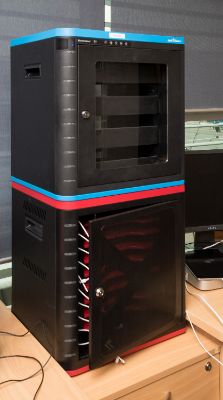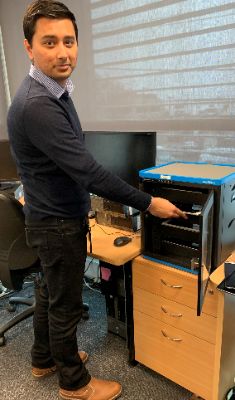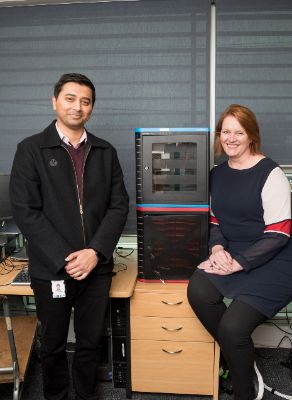Canterbury DHB The First In NZ To Use The Mobile Electronic Disinfection Unit – The ElectroClave

Canterbury DHB’s Information Services Group (ISG) is now able to safely disinfect devices such as tablets and cell phones when they are returned to ISG from wards and clinical units.
In a COVID-19 world, good hygiene has become top of many people’s minds. Mobile electronic devices such as iPads and mobile phones can carry harmful germs and can act as inadvertent ‘spreaders’ of infectious diseases. While mobile devices need regular cleaning, it isn’t as straight forward as picking up a disinfectant wipe to clean a device, given that moisture can damage electronic equipment.
This is where the ElectroClave comes in. It uses UV-C (short-wavelength ultraviolet) light for 360-degree sterilisation, killing 99.9 percent of pathogens. Its cooling system is also designed to prevent devices from being overheated. It’s already used across healthcare in several other countries.
Canterbury was the first DHB in New Zealand to trial the ElectroClave. Following its successful use, it is now the first organisation in New Zealand to be using it.
“We know that COVID-19 virus can survive on hard surfaces for up to 72 hours. This was a risk that we needed to mitigate to keep our staff safe and provide them with something they can use to do their job safely,” ISG Enterprise Devices Team Leader Rahul Mukherjee said.

How does it work?
First, the device is wiped down to remove any excess oil or dust. The device is then placed within the ElectroClave unit with the screen facing down on one of the shelves. The length of the cycle can be customised anywhere from a 60-second rapid cycle up to six minutes, depending on the size of the device.
“Since the introduction of the ElectroClave unit, we have adjusted our processes to ensure when devices come back to ISG from clinical areas to be repaired, we clean them in the ElectroClave before we start working on them.
“It gives our staff the assurance they’re working on devices that have been cleaned and cleared of any pathogens that could be passed on from the devices,” Rahul says.
Canterbury DHB’s Chief Digital Officer, Stella Ward is impressed by the unit’s ability to sanitise hard-to-clean devices, and charge them at the same time.

“From both a Health IT and infection control perspective, we have gained efficiencies in the way we manage our devices such as tablets and smart phones,” Stella says.


 Gordon Campbell: On Justin Trudeau’s Demise, In A Global Context
Gordon Campbell: On Justin Trudeau’s Demise, In A Global Context Climate Justice Taranaki: The Bill For Individualism, Corporations And Neoliberalism
Climate Justice Taranaki: The Bill For Individualism, Corporations And Neoliberalism Ministry For Culture & Heritage: New Zealand Flag Half-Masting To Mark The Funeral Of Senior Sergeant Lyn Fleming, NZ Police
Ministry For Culture & Heritage: New Zealand Flag Half-Masting To Mark The Funeral Of Senior Sergeant Lyn Fleming, NZ Police Child Poverty Action Group: Anti-poverty Groups Say Amendments To Social Security Act Will Remove Job Seekers’ Human Rights
Child Poverty Action Group: Anti-poverty Groups Say Amendments To Social Security Act Will Remove Job Seekers’ Human Rights Justice Committee: Justice Committee Reopens Submissions For Principles Of The Treaty Of Waitangi Bill To Tuesday 14 January
Justice Committee: Justice Committee Reopens Submissions For Principles Of The Treaty Of Waitangi Bill To Tuesday 14 January NZCAST: Survivors Of Abuse In Care Left Waiting - Urgent Action Needed Following Apology
NZCAST: Survivors Of Abuse In Care Left Waiting - Urgent Action Needed Following Apology Ōnuku Rūnanga: No One Wants Wastewater In Akaroa Harbour
Ōnuku Rūnanga: No One Wants Wastewater In Akaroa Harbour


